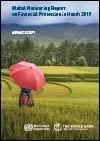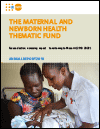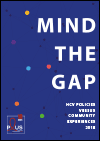What's New
Displaying results 1021 - 1030 of 4899

Resource | Publications,
For the first time this joint WHO & World Bank report on financial protection establishes global and regional 2015 baselines for an SDG indicator of catastrophic health spending and SDG related indicators of impoverishment and infers from previous trends the challenges to come in protecting people from the financial consequences of paying out of pocket for the health services they need.

Resource | Publications,
The 2030 Sustainable Development Goals emphasize having all people receive the quality health services they need without financial
hardship. Critical to attaining universal health coverage (UHC) is a formal monitoring mechanism to assess progress. This report does just that. It highlights the global coverage of health services and financial protection. It also addresses gender and equity related challenges. And it identifies primary health care as the route to universal health coverage.

Resource | Publications,
This report presents internationally comparable global, regional and country-level estimates and trends for maternal mortality between 2000 and 2017.

Resource | Publications,
This report highlights key results achieved in 2018 in the four intervention areas of the Maternal and Newborn Health Thematic Fund: midwifery, emergency obstetric and newborn care, maternal and perinatal death.

Resource | Publications,
Are we on track to achieve Goal 5? On 24 and 25 September 2019, Heads of State and Government gathered at UN Headquarters in New York to comprehensively review progress on the implementation of the 2030 Agenda for Sustainable Development and its 17 Sustainable Development Goals. To inform those discussions, UN Women and the UN Department of Economic and Social Affairs have released “Progress on the Sustainable Development Goals: The gender snapshot 2019”. This publication brings together the latest available evidence on gender equality across all 17 Goals, underscoring the progress made as well as the action still needed to accelerate progress.

Resource | Publications,
Sustainable Development Goal (SDG) 3 – ensuring health and well-being for all at all ages – is critical to achieving progress on the 2030 Agenda for Sustainable Development. Because health is an integral part of human capital and a precondition, driver and outcome of sustainable development, SDG 3 is linked to around 50 health-related targets across the SDGs and the pledge to leave no one behind. The overall objective of the Global Action Plan is to enhance collaboration among 12 global organizations engaged in health, development and humanitarian responses to accelerate country progress on the health-related SDG targets. The Plan presents a new approach to strengthening collaboration among and joint action by the organizations, building on an initial joint commitment made in October 2018. The Plan is primarily intended to be strategic but provides some operational detail to guide implementation while also allowing flexibility for adjustment based on regular reviews of progress and learning from experience.

Resource | Guidelines,
One important way to mobilise more resources and achieve a greater programmatic impact is by harnessing the full range of assets, capacities and innovations business has to offer – whether they be financial, technical or institutional.

Resource | Publications,
This report complements the evaluations of hepatitis responses conducted by fellow stakeholders. One particular inspiration was the WHO’s recent development of country response profiles through a survey on a checklist of indicators of structure (e.g., policy decisions), input (e.g., budget allocation) and process (e.g., implementation of WHO guidelines). To complement the WHO’s top-down macro-level overview of HCV responses, the Coalition PLUS survey provides a bottom-up micro-level evaluation of the HCV response at selected sites in five middleincome countries: India, Indonesia, Malaysia, Morocco, and Thailand. As an explanatory and qualitative survey, the findings and recommendations serve to inform the response in the countries involved in the study.

Resource | Publications,
Asia-Pacific is the most disaster-prone region in the world and home to a number of long-running conflicts. The United Nations Population Fund (UNFPA) places women and girls at the centre of humanitarian response. This publication shares examples of how we support actions to better mitigate the risks of disasters and support humanitarian response work that is underpinned by UNFPA’s unique mandate encompassing sexual and reproductive health, gender equality, population data and youth empowerment.

Resource | Publications,
In line with UNDP’s ‘Strategic Plan 2018–2021’ and ‘HIV, Health and Development Strategy 2016–2021: Connecting the Dots’, UNDP contributes to UHC. This UNDP Issue Brief on ‘Universal Health Coverage for Sustainable Development’ outlines UNDP’s contributions toward supporting countries to remove barriers to health and improve the affordability, accessibility and quality of health care and systems.





